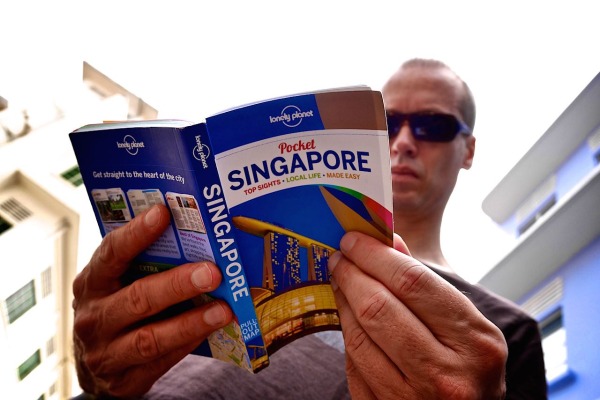

Photo: Franklin Heijnen
Started by Maureen and Tony Wheeler in 1973, Lonely Planet’s first guidebook Across Asia on the Cheap retailed for $1.80 in 1973 and advised travellers on how to do the overland journey from Europe to Australia known as the Hippie Trail. Africa on the Cheap would follow in 1977 and now Lonely Planet is the largest guidebook publisher in the world and a travel empire. It has printed more than 120 million books in 11 different languages. It sells apps, accommodation, magazines, insurance, flights and a range of other travel products and services.
In 2007, the BBC bought 75% of the company, then the remaining 25% in 2011. In 2013, the BBC sold it to American billionaire Brad Kelley who incorporated it into his NC2 Media Company. But Lonely Planet continues to sell guidebooks. While the company has obviously changed a lot since the 1970s, what is less obvious is how these changes are reflected in their guidebooks. Here are 10 differences between their old and new guidebooks:
1. The maps used to be kind-of beautiful.
Their first guidebooks had no color photos, just black-and-white hand-drawn maps that might as well have been scrawled on napkins. They were so in-the-moment, and beautiful in their simplicity. Today, their maps are still just as useful (and sometimes frustrating) except now they’re purely functional.
2. The writers showed excitement, a raw passion for travel and attention to details.
What is most evident to me in those early guidebooks was the raw passion for travel. The text was impulsive and enthusiastic. Readers were advised to go to a certain restaurant in Kabul “just for the sheer incongruity of eating apple pie in Afghanistan!” Wheeler described a specific movie he saw in India, one drink he had on Kuta Beach, and a frustrating exchange with a single rickshaw driver in Indonesia. The personalized attention to detail that makes you see the world from the perspective of a fellow backpacker made those early guidebooks so interesting.
3. Nowadays, they have to constantly look for equivalents of “friendly.”
Today, no part of Earth is too remote for a Lonely Planet writer to drop by and describe the people as friendly or as synonyms of friendly. Filipinos have a “zest for life” while the Balinese are known for their “joy of life.” Argentinians are “gregarious,” Burundians have an “irrepressible joie de vivre,” Malaysians are bursting with “friendliness and hospitality,” and the Surinamese are “incredibly friendly and generous people.” But this is nothing compared to the Irish or the Thais who are both even friendlier! We are told the friendliness of the Irish “is famous the world over” while the Thais have “legendary hospitality.”
4. They didn’t sugarcoat.
When writing the first Lonely Planet guidebook to Africa in 1977, Geoff Crowther thought Zaire was “politically a very screwed-up country,” and that Djiboutians would ingest a mild narcotic to “help them forget all those insurmountable problems.” Crowther even believed he knew what was best for Ghana, accusing its first president of spending too much money on projects “which were often unrelated and inappropriate to the country’s real needs.” I don’t know if he’s right or wrong, but it makes me want to learn more about Ghana and isn’t that the sign of a great guidebook?
What you get today is overly sanitized. For example, a 2009 guidebook described Kenyan politics as “at times tumultuous” and the DR Congo as “not that democratic.” Even the war-wracked capital of East Timor, Dili has “a quiet charm” provided you “look past the burnt-out buildings and refugee camps.” Today’s guidebooks try too hard to put a positive spin on things.
5. Clichés are way more common now.
The world of Lonely Planet guidebooks is where East Africa becomes a cultural “melting pot,” Cambodia is “a country of contradictions,” and, of course, India is “truly a land of astonishing contrasts.” Not only is every city the “pearl of,” the “jewel of,” or the “Paris of” somewhere that’s not Europe; the clichés have started repeated themselves.
In a 2004 guidebook, the DR Congo is a “mysterious and intoxicating country that Joseph Conrad described as the ‘Heart of Darkness,’” while in a later edition it was the “haunting yet unforgettable setting of Joseph Conrad’s classic Heart of Darkness.” Do clichés cancel each other out? How can a book written over a hundred years ago remain the touchstone for an entire country? For the authors of the Africa is a Country blog, mentioning Conrad is number one on their list of “Nine signs the journalism on Africa you’ve just encountered is trash.”
6. The writers no longer own the copyright.
Writers used to receive royalties so they would earn more if more copies were sold. Not anymore: now they only get fees. Has that changed the incentives to find interesting places to include? It looks like the writing process is more a production line than a creative endeavor.
7. New Guidebooks are ENORMOUS.
All of Asia was once covered in only 94 pages and all of Africa in 240. Nowadays a city guidebook can require 450 pages. Yet they still implore you to ‘pack light.’
8. Guidebook content is now wholly pre-determined through the ‘author’s brief.’
I found out about the ‘author’s brief’ in my research involving Lonely Planet guidebook writers. The brief includes everything from word counts and the quantity of accommodation options to be included but also determines the expression of political viewpoints and author opinions. But opinions make a guidebook interesting. I loved it how Tony Wheeler thought Singapore was “groovy” in 1973. I wanted to know more about the “incredible Bugis Street transvestite”’ and the “wham bang Chinese movies.” That strong evocation of place is one of the things missing in their guidebooks today.
9. They used to be so open about drugs.
The earlier guidebooks would have a section called Dope. It was included under a broader section called Health? along with information on vaccinations, food, and medicine. This was where Wheeler would explain that “Sumatran grass has a particularly good reputation” but “Afghanistan is certainly the pot heads’ paradise.” He even advised going to Nepal if “you are into heavier stuff” because that’s where “opium is also widely available.” At some point they stopped including this information (along with the question mark in the Health? chapter) but the Dope section was still there in the 1982 edition of West Asia on a Shoestring.
10. Static guides now have to compete with free, constantly updated info on the internet.
Guidebooks can’t be modified or adapted to keep pace with a dynamic and fluid world. There aren’t any ratings systems like on Trip Advisor. You have to take the author’s word for it instead of crowdsourcing opinions from hundreds of people. The expansion of Lonely Planet from publishing to travel-service provision was necessary for them to compete with all of the travel information freely available online. But, of course, if you don’t have access to a regular electricity supply or an internet connection, or if you’re in an unpopular destination — guidebooks might still be the best option.
The good thing about the printed guides is that they let us see how the world changes. In 1973, Kabul was a “fly in, fly out tourist trap.” In Mogadishu in 1977, you could enjoy the “ancient Hammawein quarter, Bonadir weavers and old mosques.” In the Iraq section, Wheeler casually explains “it is possible to hitch to Baghdad from Syria or Jordan.” In 1982, a whole page is dedicated to the Buddhas of Bamiyan — destroyed by the Taliban in 2001.
Not only war dramatically changed places. Readers were also advised to get to Bali quickly because it “shows every indication of being rapidly eroded by tourism.” But that is another story.
![]()

Posted In:
Powered by WPeMatico











